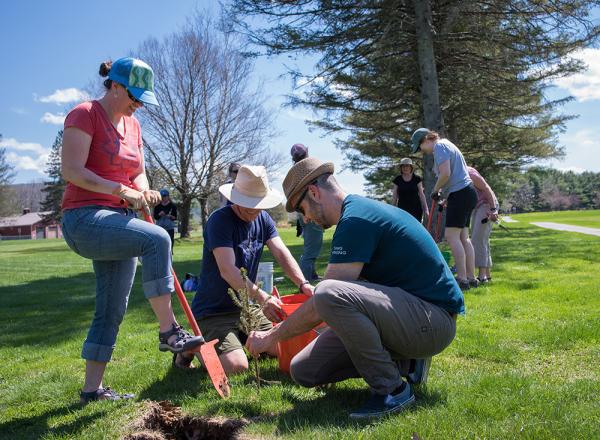Climate Change Education to Address Intergenerational Injustice
This blog was adapted from an article originally published in the Vermont Standard, April 8, 2021 for Sustainable Woodstock. Used with permission. Joan Haley is Director of Partnership Education Programs for Shelburne Farms with the National Park Service. She had help writing this article from Mateo Bango (16), Pete Wilson (22) and Carmen Bango (23).
In the field of education, climate change has become a hot topic (pun...unavoidable). It makes sense. Why wouldn’t we want to better prepare our students to address the challenges of global warming? In the past several years, research in this area has increased dramatically, offering more effective instructional strategies and learning opportunities for our youth.
Yet during a recent interview, a graduate of a local high school, politely, but pointedly, exposed an uncomfortable truth: Actions can speak louder than words or lesson plans.
When I asked her, “How do you believe climate change will impact you in 15-25 years?” the mood of the young woman shifted and the awkwardness between us mounted. It finally dawned on me what an offensive question this was. From my “privileged” position of having lived most of my life without really needing to face the consequences of climate change, it was easy to distance myself from a vision of...what? Even young children have heard of the dire predictions from scientists. It is not fun to imagine, and perhaps frustrating to hear this question from someone from a more culpable generation.
Understandably, this 19-year-old and other recent high school graduates I have interviewed are disconcerted by the lack of progress in climate change mitigation and adaptation over the past 40 years. They expressed some confusion and dismay that their elders look to them to solve this complex issue, despite those established adults having relatively more resources, connections, experience, and power to do so. Yet these graduates were still ardently trying to reduce their carbon footprints and enhance their carbon “handprints.”
While the youth attributed part of their sense of efficacy to skills and knowledge gained in school (big kudos to our local teachers!), their observations of adult actions and attitudes still deeply influenced them. Through vicarious learning, youth see what is possible and what is deemed important. “Do as I say, not as I do” doesn’t fly. Our everyday adult choices—the cars we drive, the foods we eat, the clothes we buy, the houses we build, the policies we support—send powerful signals to young people about how much we value and feel responsible for the quality of their lives and that of other beings on this planet.
It was both humbling and inspiring to realize that these youth were making more substantial lifestyle changes and working harder to change unsustainable systemic practices than many adults, including myself. While I have great faith that our community’s kids will “change the world,” is it fair to ask them to do this if we are not prepared to do it ourselves? Our teachers are working hard to foster student agency, but their efforts will be more meaningful and authentic if students can see it in action in the behaviors of the adults around them.
Here are a few things we can do, in and outside the classroom, to support the next generation:
- Make choices together using systems-thinking. For example, discuss how carpooling to a sports event might impact the community and environment.
- Volunteer and invite youth to participate. Activities such as community gardening, Green Up Day, climate rallies, or serving on boards help youth practice civic engagement and contribute their much needed perspectives. Demonstrate that these activities matter, and can also be fun and rewarding.
- Reassure young people that they don’t need to be perfect. If we fall short in one area (e.g. indulging in long showers), we can try to make up for it in others (e.g., taking fewer showers, reducing food waste in the cafeteria).
- Strive for a more sustainable lifestyle and draw attention to benefits beyond greenhouse gas reduction, such as saving money on clothes purchased from a thrift store or enjoying the taste of a fresh, locally-grown tomato.
- Learn about climate change and how to make informed choices; engage in social media or other youth interactions to exchange promising practices. Project Drawdown is an excellent resource for research-based climate solutions.
Perhaps the most vital part of climate change education is listening to our youth and learning from them. All of these ideas, while supported by research, were suggested by youth who’ve indicated they feel the heavy weight of climate change on their shoulders. Through our day-to-day efforts, we can help (re-)build our youth’s faith in the future, demonstrating through our actions that we are in this together and are working to live up to standards that youth should expect from “grown ups.”
One thing you can do: Find one climate solutions activity in Project Drawdown that calls to you and role model it for your community’s youth.


